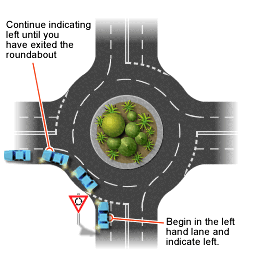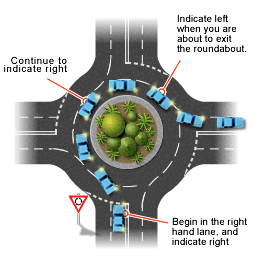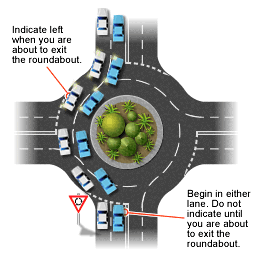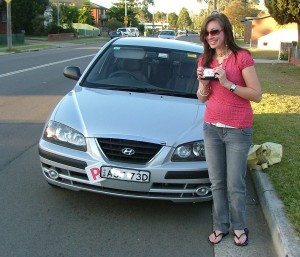Signalling
You must indicate for long enough to give sufficient warning to other drivers and pedestrians before entering a roundabout when turning left or right.
You must also indicate, if practicable, on exit when going straight ahead.
That way, people around you know exactly where you’re headed.
Traffic signals
Some roundabouts may have traffic lights on an approach.
When the signals are operating you may be stopped for a short time by a red light to allow other traffic to access the roundabout.
When the signals are not operating or when you proceed after being stopped, you are still to proceed into the roundabout under the normal roundabout rules.
Giving way
Approaching a roundabout: Vehicles entering a roundabout must give way to any vehicle already in the roundabout.
Giving way at a roundabout: means the driver must slow down and if necessary, stop to avoid a collision.
When entering, you must give way to all vehicles, including bicycles, already on the roundabout. So slow down or stop if necessary. Only enter when there is a safe gap.

Going left
Slow down and prepare to give way as you approach the roundabout.
On approach you must be in the left lane unless otherwise marked on the road, and indicate a left turn.
You must give way to traffic already on the roundabout if there is any risk of a collision.
Enter the roundabout when there is a safe gap in the traffic.
Stay in the left lane.
Keep your left indicator on until you have exited the roundabout.

Going right
Slow down and prepare to give way as you approach the roundabout.
On approach you must be in the right lane unless otherwise marked on the road, and indicate a right turn.
You must give way to traffic already on the roundabout if there is any risk of a collision.
Enter the roundabout when there is a safe gap in the traffic.
Stay in the right lane.
You must indicate a left turn just before your exit unless it is not practical to do so.

Going straight ahead
Slow down and prepare to give way as you approach the roundabout.
On approach you can be in either lane, unless otherwise marked on road.
When going straight ahead you do not need to indicate on approach.
You must give way to traffic already on the roundabout if there is any risk of collision.
Enter the roundabout when there is a safe gap in the traffic.
You must indicate a left turn just before you exit unless it is not practical to do so.
The rules for slowing down, giving way and signalling when approaching and exiting at roundabouts are the same for single lane and multi-lane roundabouts.
Roundabouts: risks to watch for
Take extra care whenever you drive in a roundabout.
Keep an eye out for cars that are leaving the roundabout.
Be careful if changing lanes in a roundabout, particularly
when leaving.
Look out for vehicles that are making a full turn.
Watch for bicycles, long vehicles and motorcycles.

